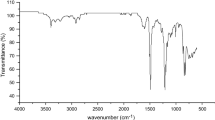Abstract
The thermal behaviour of three aromatic polymers, poly(3,3-dioxy-4,4-diphenylmethane) (POA), poly(2,2-m-phenylene-5,5-dibenzoxazolemethane) (PBO) and a commercial poly-(phenyleneisophthalamide) (Phenylon) was studied by thermal analysis, i.e. DSC and TG. PBO was formed by the progressive thermocyclization of POA. By transforming POA into PBO the thermal stability was increased proportionally to the degree of cyclization, due to the stiffening of the polymer chain. PBO was found to be more thermally stable than Phenylon. The activation energies of the desorption of moisture, cyclization and thermal degradation of the polymers in both nitrogen and air were determined from non-isothermal TG data.
Zusammenfassung
Mittels DSC und TG wurde das thermische Verhalten von drei aromatischen Polymeren untersucht: Poly(3,3-dioxy-4,4-diphenylmethan) (POA), Poly(2,2-m-Phenylen-5,5-dibenzoxazolmethan) (PBO) und handelsübliches Poly (phenylen-isophthalamid) (Phenylon). PBO in PBO erhöht sich wegen der Versteifung der Polymerketten die thermische Stabilität proportional zum Cyclisierungsgrad. PBO ist thermisch stabiler als Phenylon. Anhand der nichtisothermen TG-Daten wurden sowohl in Stickstoff als auch in Luft die Aktivierungsenergien von Feuchtigkeitsdesorption, Cyclisierung und thermischem Abbau der Polymere ermittelt.
Similar content being viewed by others
References
C. David, ‘Thermal Degradation of Polymers’ in ‘Comprehensive Chemical Kinetics’, Eds. C. H. Bamford, C. F. H. Tipper, Vol. 14, Elsevier, Amsterdam 1975, pp. 131–152.
A. A. Atrushkevich and A. J. Alekseev, Polim. Stroit. Mater., (1975) 103.
A. A. Atrushkevich, Yu. I. Tolchinskii, V. A. Khomutov, G. M. Tseitlin and V. V. Korshak, Vysokomol. Soedin., Ser A,21 (1979) 229.
V. V. Korshak, S. A. Pavlova, I. A. Gribova, P. N. Gribkova, Yu. L. Aretisyan, N. I. Bekasova and L. G. Komarova, Vysokomol. Soedin. Ser A, 21 (1979) 30.
N. N. Vosnesenskaya, G. I. Braz, A. Ya. Yakubovich, Vysokomol. Soedin. Ser A, 14 (1975) 1822.
T. Ozawa, J. Thermal Anal., 5 (1973) 563.
T. Ozawa, J. Thermal Anal., 7 (1975) 601.
H. E. Kissinger, Anal. Chem., 29 (1957) 1702.
J. H. Flynn and L. A. Wall, Polym. Letters, 4 (1966) 323.
Author information
Authors and Affiliations
Rights and permissions
About this article
Cite this article
Voloshchuk, K.A., Popovic, I., Martinov, S.V. et al. The thermal transformation of an aromatic poly (amide), poly (ortho-oxyamide) and poly (benzoxazole). Journal of Thermal Analysis 40, 773–782 (1993). https://doi.org/10.1007/BF02546651
Published:
Issue Date:
DOI: https://doi.org/10.1007/BF02546651




